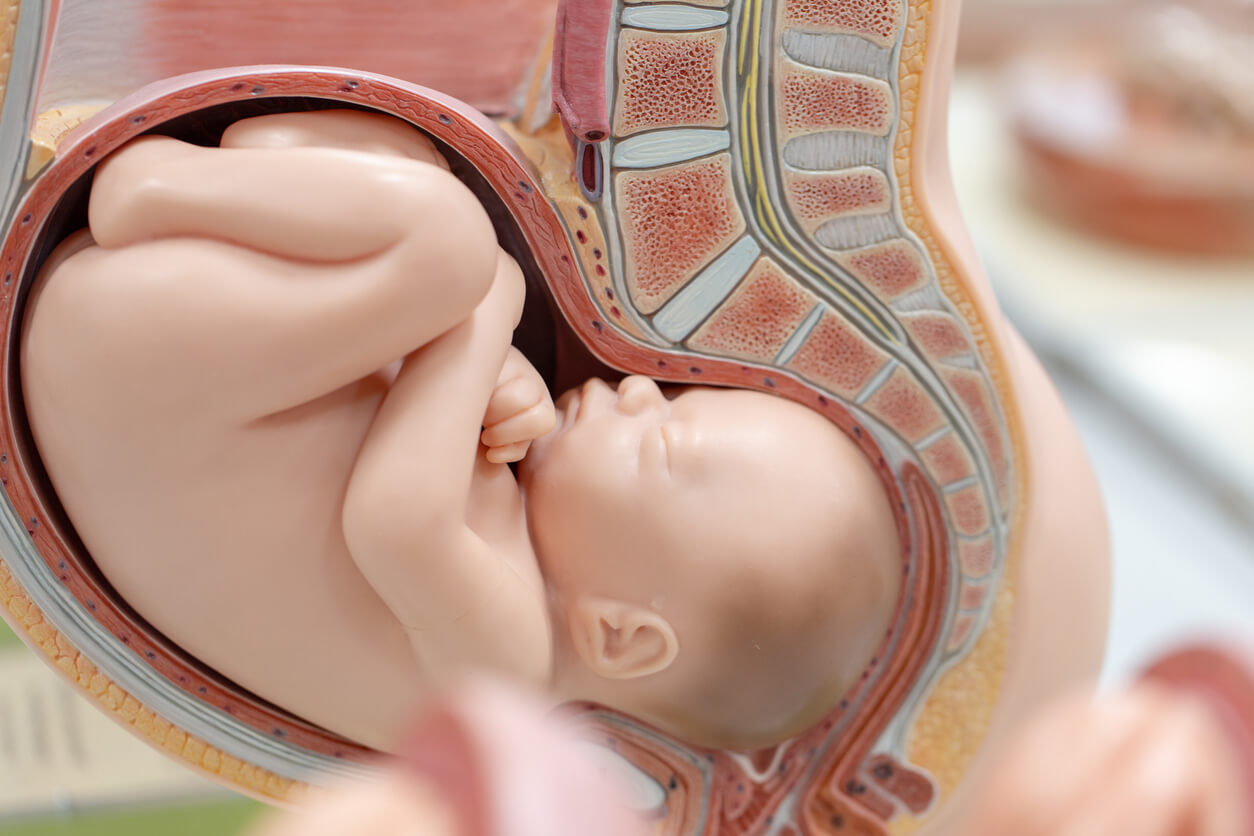When a Baby Descends into the Pelvis During Pregnancy

In the last weeks of pregnancy, the mother’s body is finalizing details in preparation for childbirth. One step that indicates that this process is progressing favorably is when the baby descends into the pelvis of the mother.
Although it’s sometimes a rather uncomfortable and annoying event for the pregnant woman, it’s absolutely necessary in order to promote vaginal delivery. But when does the baby do this? We’ll tell you all about it below.
What does it mean when the baby descends into the pelvis?
We must begin by clarifying that when we talk about the descent of a baby into the mother’s pelvis, we’re describing the process of the baby turning around, head down, and entering the birth canal, inside the maternal pelvis.
In most cases, the part of the baby’s body that descends into the pelvis is the baby’s head, as the cephalic position is ideal for vaginal delivery. However, it may happen that the baby is breech, meaning that the baby’s bottom is inserted (breech position).
When the baby is inserted in the cephalic position, it’s usually with the baby’s face towards the mother’s spine, so that the widest part of the baby’s head exceeds the upper narrowing of the pelvis.

When does this descent occur?
Your baby descends into the birth canal in the last few weeks of gestation because at this stage, the shape of the uterus and the weight the baby has gained help the baby settle into the mother’s pelvis.
Although there’s no exact time for this to occur, it’s common for babies to descend after 33 weeks. However, in many pregnancies, this may occur only a few days before or during labor.
What will you feel when your baby descends into the pelvis?
As with all pregnancies, the symptoms experienced by mothers are very individual, some feel nothing in particular, while others may feel increased pressure in the pelvic area. Generally speaking, the baby’s wedging in the birth canal is accompanied by manifestations such as the following:
- The belly feels lower and may tilt forward.
- The mother feels that she breathes better and doesn’t feel so heavy after eating, as the pressure exerted by the uterus on the diaphragm decreases.
- It may bring some pelvic discomfort such as cramps or twinges in the area.
- When walking, you may feel discomfort or slight pain, as well as less balance when walking.
- The sensation of wanting to urinate frequently increases even more, due to the baby putting more pressure on the bladder.
Why hasn’t my baby descended yet?
There are factors that can intervene and delay the baby’s descent process, among which the following stand out:
- Previous pregnancies: The abdominal muscles and tissues are more flaccid than in new mothers, which allows the baby to move more comfortably and delays its insertion.
- Large babies: If the baby’s large for its gestational age, it may be necessary to begin uterine contractions in order to favor its descent through the birth canal.
- Narrow pelvis: if there’s a disproportion between the size of the fetus and the mother’s pelvis, it’s likely that this descent will be difficult. In these cases, specialists indicate delivery by cesarean section.
- Mother’s activity: Another factor that intervenes in the process is the position that the mother adopts, usually between the eighth and ninth months. If she’s frequently sitting or lying down, the baby will rest its back on the pelvis and won’t settle in a position that favors this process. For this reason, the mother should move and walk around in the last weeks of gestation.

How can I help the baby descend into the pelvis?
If after 37 weeks, the baby hasn’t descended, it’s a good idea to exercise to favor this process. It’s best to walk moderately for at least half an hour a day, swim, do prenatal yoga or Pilates.
Similarly, the doctor or midwife can indicate some specific exercises for this purpose, accompanied by massages in the abdominal area. It’s important to clarify that this step of descent is physiological and in many cases, it may not happen even if these types of exercises are performed.
However, if the baby doesn’t descend after the onset of labor contractions, it will be necessary to resort to a cesarean section. However, if the baby is in the cephalic position and labor is proceeding normally, it’s unlikely that the baby fail to descend in time.
In the last weeks of pregnancy, the mother’s body is finalizing details in preparation for childbirth. One step that indicates that this process is progressing favorably is when the baby descends into the pelvis of the mother.
Although it’s sometimes a rather uncomfortable and annoying event for the pregnant woman, it’s absolutely necessary in order to promote vaginal delivery. But when does the baby do this? We’ll tell you all about it below.
What does it mean when the baby descends into the pelvis?
We must begin by clarifying that when we talk about the descent of a baby into the mother’s pelvis, we’re describing the process of the baby turning around, head down, and entering the birth canal, inside the maternal pelvis.
In most cases, the part of the baby’s body that descends into the pelvis is the baby’s head, as the cephalic position is ideal for vaginal delivery. However, it may happen that the baby is breech, meaning that the baby’s bottom is inserted (breech position).
When the baby is inserted in the cephalic position, it’s usually with the baby’s face towards the mother’s spine, so that the widest part of the baby’s head exceeds the upper narrowing of the pelvis.

When does this descent occur?
Your baby descends into the birth canal in the last few weeks of gestation because at this stage, the shape of the uterus and the weight the baby has gained help the baby settle into the mother’s pelvis.
Although there’s no exact time for this to occur, it’s common for babies to descend after 33 weeks. However, in many pregnancies, this may occur only a few days before or during labor.
What will you feel when your baby descends into the pelvis?
As with all pregnancies, the symptoms experienced by mothers are very individual, some feel nothing in particular, while others may feel increased pressure in the pelvic area. Generally speaking, the baby’s wedging in the birth canal is accompanied by manifestations such as the following:
- The belly feels lower and may tilt forward.
- The mother feels that she breathes better and doesn’t feel so heavy after eating, as the pressure exerted by the uterus on the diaphragm decreases.
- It may bring some pelvic discomfort such as cramps or twinges in the area.
- When walking, you may feel discomfort or slight pain, as well as less balance when walking.
- The sensation of wanting to urinate frequently increases even more, due to the baby putting more pressure on the bladder.
Why hasn’t my baby descended yet?
There are factors that can intervene and delay the baby’s descent process, among which the following stand out:
- Previous pregnancies: The abdominal muscles and tissues are more flaccid than in new mothers, which allows the baby to move more comfortably and delays its insertion.
- Large babies: If the baby’s large for its gestational age, it may be necessary to begin uterine contractions in order to favor its descent through the birth canal.
- Narrow pelvis: if there’s a disproportion between the size of the fetus and the mother’s pelvis, it’s likely that this descent will be difficult. In these cases, specialists indicate delivery by cesarean section.
- Mother’s activity: Another factor that intervenes in the process is the position that the mother adopts, usually between the eighth and ninth months. If she’s frequently sitting or lying down, the baby will rest its back on the pelvis and won’t settle in a position that favors this process. For this reason, the mother should move and walk around in the last weeks of gestation.

How can I help the baby descend into the pelvis?
If after 37 weeks, the baby hasn’t descended, it’s a good idea to exercise to favor this process. It’s best to walk moderately for at least half an hour a day, swim, do prenatal yoga or Pilates.
Similarly, the doctor or midwife can indicate some specific exercises for this purpose, accompanied by massages in the abdominal area. It’s important to clarify that this step of descent is physiological and in many cases, it may not happen even if these types of exercises are performed.
However, if the baby doesn’t descend after the onset of labor contractions, it will be necessary to resort to a cesarean section. However, if the baby is in the cephalic position and labor is proceeding normally, it’s unlikely that the baby fail to descend in time.
All cited sources were thoroughly reviewed by our team to ensure their quality, reliability, currency, and validity. The bibliography of this article was considered reliable and of academic or scientific accuracy.
- Cunningham, F. et al (2015) CAPÍTULO 22: Trabajo de parto normal. Williams. Obstetricia, 24e McGraw Hill. Recuperado de: https://accessmedicina.mhmedical.com/content.aspx?bookid=1525§ionid=100455028
- Mayo Clinic (2020). Presentación fetal antes del nacimiento. Recuperado de: https://www.mayoclinic.org/es-es/healthy-lifestyle/pregnancy-week-by-week/multimedia/fetal-positions/sls-20076615
- Piñango, P. et al. (2006). Desproporción fetopélvica: diagnóstico ecosonográfico. Revista de Obstetricia y Ginecología de Venezuela. Vol.66 Nº1. Caracas mar. 2006. Recuperado de: http://ve.scielo.org/scielo.php?script=sci_arttext&pid=S0048-77322006000100003
This text is provided for informational purposes only and does not replace consultation with a professional. If in doubt, consult your specialist.








